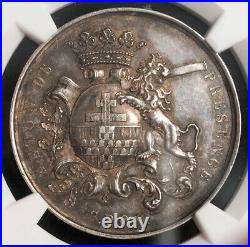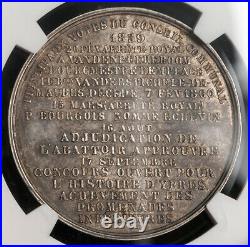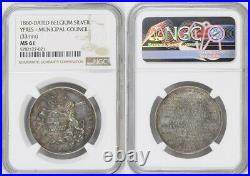1860, Belgium, Ypres (CIty). Scarce Silver Municipal Council Medal. NGC MS-61




Scarce Silver "Municipal Council" Medal. Mint Year: 1860 Medallist: Jacques Wiener Condition. Certified and graded by NGC as MS-61! Reference: City Museum of Ghent inventory no. Denomination: Medal / Jeton de Presence.
Struck to be given to attending (and voting) members of the City Council of Ypres during 1859/1860. Diameter: 33mm Material: Silver Weight: 10gm.
Obverse: Crowned coat of arms of the City of Ypres on wreath, held on the right by a standing lion looking to the right and carrying a cannon on his shoulder. Legend: JETON DE PRESENCE Exergue: S. Reverse: Inscription in 18 lines. Legend: PRINCIPAUX VOTES DU CONSEIL COMMUNAL / 1859 / 26 FÉV ARRÊTÉ ROYAL / A VAN DEN PEEREBOOM / BOURGEMESTRE REMPLACE / LEBon VANDERSTICHELE-DE- / MAUBUS, DECEDE 7 FEV 1860 / 15 MARS (ARRETÉ ROYAL) / P.
/ 16 AOUT / ADJUDICATION DE, / L'ABATTOIR APPROUVÉE. / 17 SEPTEMBRE / CONCOURS OUVERT POUR / L'HISTOIRE D'YPRES / ACHEVEMENT DES / PROMENADES / INTERIEURS: L. Ypres (Ieper in Flemish) is a Belgian city and municipality in the province of West Flanders.
Though the Flemish name Ieper is the official one, the city's French name Ypres is most commonly used in English. The municipality comprises the city of Ypres/Ieper and the villages of Boezinge, Brielen, Dikkebus, Elverdinge, Hollebeke, Sint-Jan, Vlamertinge, Voormezele, Zillebeke, and Zuidschote. Together, they are home to about 34,900 inhabitants. Ypres is an ancient town, known to have been raided by the Romans in the first century BC.It is first mentioned by name in 1066 and is probably named after the river Ieperlee on the banks of which it was founded. During the Middle Ages, Ypres was a prosperous Flemish city with a population of 40,000 in 1200 AD, renowned for its linen trade with England, which was mentioned in the.
As the third largest city in the County of Flanders (after Ghent and Bruges) Ypres played an important role in the history of the textile industry. Textiles from Ypres could be found in the markets of Novgorod in Kievan Rus' in the early 12th century.In 1241, a major fire ruined much of the old city. The powerful city was involved in important treaties and battles, including the Battle of the Golden Spurs, the Battle at Mons-en-Pévèle, the Peace of Melun, and the Battle of Cassel.
The famous Cloth Hall was built in the 13th century. Also during this time cats, then the symbol of the devil and witchcraft, were thrown off Cloth Hall, possibly because of the belief that this would get rid of evil demons. Today, this act is commemorated with a triennial Cat Parade through town.
During the Norwich Crusade, led by the English bishop Henry le Despenser, Ypres was besieged from May to August 1383, until French relief forces arrived. After the destruction of Thérouanne, Ypres became the seat of the new Diocese of Ypres in 1561, and Saint Martin's Church was elevated to cathedral. On 25 March 1678 Ypres was conquered by the forces of Louis XIV of France. It remained French under the Treaty of Nijmegen, and Vauban constructed his typical fortifications that can still be seen today.
During the War of the Spanish Succession, the Duke of Marlborough in 1709 intended to capture Ypres, at the time a major French fortress, but changed his mind owing to the long time and effort it had taken him to capture Tournai and apprehension of disease spreading in his army in the poorly drained land around Ypres (see Battle of Malplaquet). In 1713 it was handed over to the Habsburgs, and became part of the Austrian Netherlands. In 1782 the Habsburg Emperor Joseph II ordered parts of the walls torn down. This destruction, which was only partly repaired, made it easier for the French to capture the city in the 1794 Siege of Ypres during the War of the First Coalition. In 1850 the Ypresian Age of the Eocene Epoch was named on the basis of geology in the region by Belgian geologist André Hubert Dumont.Ypres had long been fortified to keep out invaders. Parts of the early ramparts, dating from 1385, still survive near the Rijselpoort (Lille Gate). Over time, the earthworks were replaced by sturdier masonry and earth structures and a partial moat. Ypres was further fortified in the 17th and 18th centuries while under the occupation of the Habsburgs and the French. Major works were completed at the end of the 17th century by the French military engineer Sébastien Le Prestre de Vauban.
The item "1860, Belgium, Ypres (CIty). Scarce Silver Municipal Council Medal. NGC MS-61" is in sale since Tuesday, September 14, 2021. This item is in the category "Coins & Paper Money\Coins\ World\Europe\Belgium". The seller is "coinworldtv" and is located in Wien. This item can be shipped worldwide.- Composition: Silver
- Country/Region of Manufacture: Belgium
- Certification: NGC
- Denomination: Medal
- KM Number: See detailed description section for full data!
- Grade: MS 61
- Year: 1860
